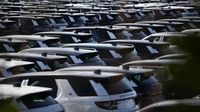Car sales between the United Kingdom and the United States are showing signs of life after several turbulent months, thanks to a new trade agreement that’s put the brakes on steep tariffs and given British automakers a reason to hope. According to the Society of Motor Manufacturers and Traders (SMMT), sales of British-made cars to the US rose by 6.8% in July 2025, marking the first increase after three consecutive months of decline. This uptick comes on the heels of a deal between London and Washington that slashed tariffs on UK car exports—an intervention that industry insiders say was badly needed after a bruising spring.
Earlier this year, the industry was rattled when US President Donald Trump hiked import taxes on UK cars from a modest 2.5% all the way up to 27.5%. The move, which took effect in April, sent shockwaves through British carmakers, particularly those who rely heavily on the American market. As reported by BBC, the sudden tariff spike forced luxury manufacturers like Jaguar Land Rover (JLR) and Aston Martin to pause or limit their shipments across the Atlantic. The numbers reflected the pain: new car sales to the US slumped 55.4% year-on-year in May, following smaller declines in April and June, according to AFP and BGNES.
But in May, the two governments hammered out a compromise. The UK-US trade agreement, which became effective at the end of June, reduced tariffs on UK car exports to 10%—but only for the first 100,000 cars shipped each year. That quota roughly matches the number of British cars exported to the US in 2024. Any cars sent above that cap are still subject to the punishing 27.5% rate, a detail that keeps the pressure on manufacturers to watch their numbers closely.
The impact of the new deal was almost immediate. In July, nearly 10,000 British cars made their way to US shores, reversing the downward trend and providing a much-needed boost for the sector. The SMMT said July’s figures “illustrate the impact of this deal,” highlighting just how pivotal the agreement has been. “The US remains the largest single national market for British-built cars, underscoring the importance of the UK-US trade deal,” the association stated, as reported by BBC and AFP.
Colleen McHugh, chief investment officer at Wealthify, weighed in on the significance of the American market. “In particular, it is a key market for premium brands like Jaguar Land Rover,” she told BBC. JLR, which had halted shipments in April due to the tariff hike, resumed exports in May once the new terms were announced. Aston Martin also returned to the US market after limiting deliveries during the period of higher tariffs, according to BGNES.
Despite this positive turn, the broader picture for UK car manufacturing remains challenging. Overall vehicle output for the year to date in 2025 is down 11.7%, a figure that includes both cars and commercial vehicles. In fact, car manufacturing in the UK fell to its lowest level since 1953 as of July, a sobering statistic that industry experts attribute to a combination of higher UK labor costs, fierce competition from overseas, and the lingering effects of Brexit.
Mike Hawes, chief executive of the SMMT, commented on the situation, saying, “It remains a turbulent time for automotive manufacturing, with consumer confidence weak, trade flows volatile and massive investment in new technologies underway both here and abroad. Given this backdrop, another month of growing car output is good news.” His words, reported by BBC, capture the cautious optimism that now pervades the sector.
The European Union, meanwhile, remains a much larger market for UK carmakers, accounting for 45.6% of exports in July, compared to the US’s 18.1%. Nearly 80% of cars manufactured in the UK last year were exported, mainly to the EU, according to BGNES. The UK automotive sector is also dominated by foreign brands, including Japanese giant Nissan and Indian-owned JLR, with luxury models like Bentley and Rolls-Royce (both German-owned) finding eager buyers in the US.
Zooming out to the continental scene, the European car market has enjoyed a rare moment of growth. According to data from the European Automobile Manufacturers Association (ACEA), new car sales in Europe rose by 5.9% in July 2025, the best performance in over a year. Plug-in hybrid sales in the EU saw their biggest jump since at least January 2023, and battery-electric cars experienced their most significant increase since August 2023. Germany, which had recently overhauled its electric vehicle incentive system, recorded a remarkable 58% rise in battery electric vehicle (BEV) sales and an 83.6% jump in plug-in hybrid electric vehicle (PHEV) sales for July.
Despite the surge in electric vehicle sales, not all automakers are celebrating. Tesla’s market share in Europe dropped for the seventh consecutive month, with sales tumbling 40.2% and market share shrinking to 0.8% from 1.4% the previous year, according to Reuters. In contrast, Chinese automaker BYD made a splash, with sales up 225.3% and a market share of 1.2%—its first appearance in the monthly sales data. Overall, registrations of battery electric, hybrid electric, and plug-in hybrid cars accounted for nearly 60% of new car registrations in July, up from just over half a year earlier.
But the gains weren’t spread evenly across Europe. While total EU car sales rose 7.4%, and Germany posted an 11.1% increase in overall sales, the UK market fell 5%, with France and Italy also seeing declines. Spain, Poland, and Austria, on the other hand, recorded robust increases of 17.1%, 16.5%, and 31.6%, respectively.
With so many moving parts in the global automotive landscape, the UK’s recent uptick in US-bound exports is a rare bright spot. The industry still faces daunting headwinds—ranging from shifting trade policies and rising costs to the rapid transition toward electric vehicles and the complexities of post-Brexit trade. Yet, as July’s numbers show, targeted policy changes can make a real difference, at least in the short term. For now, British carmakers are hoping that the momentum from the new tariff deal will help them steer through the rough road ahead.

